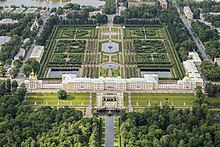| UNESCO World Heritage Site | |
|---|---|
 | |
| Official name | Historic Centre of Saint Petersburg and Related Groups of Monuments |
| Criteria | Cultural: (i)(ii)(iv)(vi) |
| Reference | 540bis |
| Inscription | 1990 (14th Session) |
| Area | 3,934.1 ha |
| Coordinates | 59°53′04″N 29°54′32″E / 59.88444°N 29.90889°E |
The Peterhof Palace (Russian: Петерго́ф, romanized: Petergóf, IPA: [pʲɪtʲɪrˈɡof];[1] an emulation of German "Peterhof", meaning "Pieter's Court")[2] is a series of palaces and gardens located in Petergof, Saint Petersburg, Russia, commissioned by Peter the Great as a direct response to the Palace of Versailles by Louis XIV of France.[3] Originally intending it in 1709 for country habitation, Peter the Great sought to expand the property as a result of his visit to the French royal court in 1717,[3] inspiring the nickname of "The Russian Versailles".[4] The architect between 1714 and 1728 was Domenico Trezzini, and the style he employed became the foundation for the Petrine Baroque style favored throughout Saint Petersburg.[5] Also in 1714, Jean-Baptiste Alexandre Le Blond, likely chosen due to his previous collaborations[6] with Versailles landscaper André Le Nôtre, designed the gardens. Francesco Bartolomeo Rastrelli completed an expansion from 1747 to 1756 for Elizabeth of Russia. The palace-ensemble along with the city center is recognized as a UNESCO World Heritage Site.

- ^ ⟨h⟩ is commonly/historically transliterated into Russian as ⟨г⟩ (g), so German Peterhof is transliterated as "Петергoф" Petergof.
- ^ Adrian Room, "Petrodvorets", Placenames of the world: origins and meanings of the names for over 5000 Natural Features, Countries, Capitals, Territories, Cities and Historic sites (1997) p. 282
- ^ a b "Peterhof | Russia". Encyclopedia Britannica. Encyclopædia Britannica, inc. 2015-06-09. Retrieved 2018-11-17.
- ^ "Peterhof (Petrodvorets)". Saint-Petersburg.com. 2018. Retrieved 2018-11-17.
- ^ "Biography of Domenico Trezzini, architect in St. Petersburg". www.saint-petersburg.com. Retrieved 2018-11-17.
- ^ "Alexandre-Jean-Baptiste Le Blond | French landscape designer". Encyclopedia Britannica. Retrieved 2018-11-17.